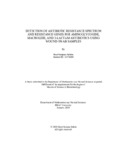Detection of antibiotic resistance spectrum and resistance genes for aminoglycoside, macrolide, and β-lactam antibiotics using wound swab samples

View/
Date
2020-01Publisher
Brac UniversityAuthor
Safain, Kazi SarjanaMetadata
Show full item recordAbstract
Antibiotic resistance has become a global health problem with a decrease in efficacy in treating common infections, resulting in increased sufferings, duration of hospital stay and economic burden. Infections in the wound site by multi-drug resistant pathogens play an important role in the development of chronicity and delaying wound healing.
Unfortunately, information regarding resistance spectrum of the isolates and the associated genes, which are important for physicians in order to prescribe empirical
treatment as well as to contain the spread of infections, is still lacking in Bangladesh.
Hence, the aim of this study was to investigate antibiotic resistance in pathogenic organisms, isolated from wound sites, both phenotypically and genotypically. A total
of 217 specimens were collected from outpatients affected with wound infections who visited for dressing purpose at Bangladesh Institute of Health Sciences Hospital (BIHS) and Shaheed Suhrawardy Medical College & Hospital, from January 2017 to March
2019. Identification and confirmation of the isolates were done by appropriate microbiological and biochemical methods. Furthermore, antibiogram was performed using Kirby–Bauer disk diffusion approach. PCR was performed using ESBL, macrolide and aminoglycoside resistance gene specific primers and subsequently Sanger sequencing was conducted for further confirmation of the genes. A total of 348 bacterial strains (MRSA- 17.82%, S. aureus- 6.32%, S. pneumoniae- 10.33%,
Enterococcus spp.- 7.76%, CNS- 8.05%, A. baumannii- 5.75%, E. coli- 24.43%, K.
pneumoniae- 12.07% and P. aeruginosa- 7.47%) were isolated. Co-infections were found in 25·3% of the samples and the most common association (13%) was found
between MRSA and K. pneumoniae. Besides, antibiogram data revealed that about 54% strains were multidrug resistant (MDR). E. coli (96.6%) followed by MRSA (90%)
isolates were found to be the most prevalent type of MDR pathogens. The MAR
(multiple antibiotic resistance) index exhibited that more than half of the organisms
(58.05%) had a MAR value of greater than 0.2 and for P. aeruginosa, the mean value
(0.562) was significantly higher than other organisms tested. In addition, PCR results revealed that among the 5 ESBL genes investigated, CTXM-1 (53.71%) and NDM-1
(12.4%) were the most prevalent and these genes were predominant in E. coli. ErmB
(38.2%) was the most common gene among the macrolide resistance genes. Also, Aac(3)-II -25.44% was the frequently detected gene among the aminoglycoside group.
Moreover, the results obtained from investigation of co-resistance displayed that coexistence of CTXM-1 and ErmB (16.66%) was the most common phenomenon.
Interestingly, an increasing trend in the proportion of MDR organisms was seen
between the years of 2017 and 2019. Such alarming escalation of antibiotic resistance impedes the treatment and prevention of infectious diseases, resulting in increased morbidity and mortality. Therefore, nationwide surveillance as well as development of alternative strategies needs to be propagated to resolve this serious issue in the hospital settings of Bangladesh.
Keywords
Antibiotic resistance; Wound infection; Multidrug resistance; Resistance genes; Infectious diseasesDescription
This thesis report is submitted in partial fulfillment of the requirement for the degree of Master of Science in Biotechnology, 2020.Department
Department of Mathematics and Natural Sciences, Brac UniversityType
ThesisCollections
Related items
Showing items related by title, author, creator and subject.
-
Current Antibiotic-resistant crisis and initiatives to combat antimicrobial resistance: A review from global perspective
Bhowmick, Anaxme; Oishi, Tashrifa Shahreen; Aishy, Rideeta Islam (Brac University, 2022-05)Anti-microbial resistance is rising as one of the worldwide threats all over the planet due to microorganisms' regular hereditary transformation as well as restricting acknowledgment of a medication. In addition, ... -
Assessment of the antimicrobial sensitivity of Acinetobacter baumannii collected from the environment of neonatal ward of a rural hospital of Bangladesh
Sharon, Sharonika (Brac University, 2024-08)Background: Healthcare associated infection caused by multi drug resistant Acinetobacter baumannii is not only becoming increasingly prevalent in hospital settings but also becoming a huge challenge for the healthcare ... -
Detection and characterization of antibiotic resistant and biofilm producing clinical isolates of Acinetobacter baumannii
Alam, Jarifa; Faruk, Ruhama Binte; Anik, Kamrul Hasan (Brac University, 2024-08)Acinetobacter baumannii is an opportunistic pathogen that affects persons with weakened immune systems and causes nosocomial infections due to its antibiotic resistance. Because of the global proliferation of multidrug ...



